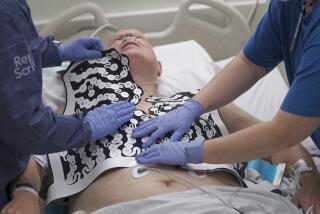Repairing damaged hearts
- Share via
PEOPLE who survive heart attacks rarely return to perfect health -- and most suffer permanent damage. During cardiac arrest, the heart stops pumping blood, causing oxygen-deprived heart muscle cells to die. This weakens the heart and causes scarring. The remaining heart muscle cells must then work harder pumping blood to compensate, leading to an often deadly condition known as congestive heart failure.
Currently there’s no way to repair injured cardiac tissue, but experimental therapies using adult stem cells may one day be able to help rejuvenate ailing hearts and halt progressive heart failure, allowing disabled cardiac patients to resume normal living and potentially saving thousands of lives.
“This is a very hot area in cardiology research and could revolutionize the way we treat people with heart attacks,” says Dr. Robb MacLellan, a cardiologist researching stem cells at UCLA’s David Geffen School of Medicine. “But at the moment, there are still a lot of unknowns.”
An estimated 7 million living Americans have suffered at least one heart attack, which puts them at greater risk for another, potentially fatal, heart attack or for the agonizing slow death of chronic heart failure. The sickest are frequently hospitalized and live tethered to oxygen tanks, unable to do the simplest chores without gasping for air. Half of all heart failure sufferers die within five years of diagnosis, according to statistics from the American Heart Assn.
Scientists hope adult stem cells could change this bleak prognosis by regenerating injured cardiac muscles and arteries. Though they’re not nearly as versatile as stem cells extracted from embryos, adult stem cells can still be coaxed into becoming a variety of cells required for organ or tissue functioning.
Early research in small numbers of animals has been quite promising, MacLellan says. When stem cells harvested from bone marrow or skeletal muscle were injected into the hearts of mice or pigs that underwent experimentally induced heart attacks, both blood flow and heart function improved. Scientists don’t know why stem cells helped hearts heal in these studies -- whether they actually turn into new cardiac muscle, secrete chemicals that prevent the heart muscle cells from dying or stimulate the formation of new blood vessels. “How they actually work is the million-dollar question,” says Dr. Steven P. Schulman, a cardiologist at Johns Hopkins School of Medicine who is studying stem cells.
Clinical trials in humans have begun across the country, though some scientists have reservations. “These therapies showed benefit in animals, but we don’t know how they will translate to humans,” says UCLA’s MacLellan.
One avenue of research involves a specialized type of adult stem cell called a mesenchymal stem cell, which is harvested from the bone marrow. Because this type of stem cell doesn’t trigger an immune response, patients can receive it from other donors without needing anti-rejection drugs.
In a study presented in 2004, scientists induced heart attacks in 14 pigs, then treated half of them with mesenchymal stem cells extracted from another pig’s bone marrow, injecting the cells directly into the animals’ hearts. The remainder were treated with a placebo. Pigs receiving the stem cells made a nearly full recovery, while the untreated animals developed congestive heart failure within two months after the heart attack.
“We produced a dramatic improvement in heart function and eradicated about 50% to 75% of the scar tissue,” says Dr. Joshua M. Hare, a cardiologist at the Johns Hopkins School of Medicine in Baltimore who conducted the study. “Cardiac functioning was nearly but not completely restored to normal.”
Scientists at Hopkins and five other research centers launched a small human test of this therapy earlier this year. Mesenchymal stem cells from a universal human donor are being used, but rather than being injected directly into the heart, they’re infused into the patients’ bloodstream through an IV. Because of this, and because a universal donor is used, “the hope is that this therapy eventually could be used in any emergency room,” says Hare.
The study will involve 48 patients who experienced their first heart attack within the previous 10 days. Thirty-six patients will receive various dosages of the stem cell treatment, while the remainder will serve as a control group. Patients are being enrolled right after a heart attack because research suggests that the newly damaged heart muscle releases chemicals called chemokines that act like a beacon to the stem cells.
“It’s like an internal homing device that attracts cells circulating in the bloodstream to the heart,” says Schulman, one of the study’s investigators.
Patients’ heart function will be measured by MRI (magnetic resonance imaging) tests at the beginning and end of the study, and participants will be followed for two years after treatment. Test results won’t be available for a few years, but plans are already underway to begin expanded clinical trials of this treatment sometime next year.
“We are on the cusp of an entirely new era in cardiology where we may be able to actually reverse the damage done by heart attacks,” Hare says.
*
(BEGIN TEXT OF INFOBOX)
Stem cell research
In addition to mesenchymal stem cells, scientists are working on other approaches using different types of adult stem cells. German scientists recently completed two studies of 100 cardiac patients that used stem cells extracted from volunteers’ bone marrow. Cells were injected into the heart, improving cardiac function by at least 10%. And European researchers recently launched a 300-patient trial using skeletal stem cells harvested from muscle in participants’ legs. The cells will be injected directly into the heart in hopes of strengthening the heart muscle around the tissue damaged by a heart attack.






